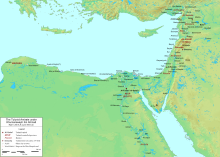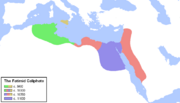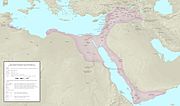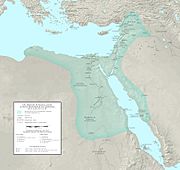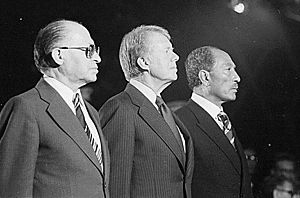History of Egypt facts for kids
The history of Egypt is very long and rich! It all started thanks to the Nile River, which brought fertile land, and the amazing people who lived there. For a long time, much of ancient Egypt's story was a mystery. But then, the Rosetta Stone was found, which helped experts understand ancient Egyptian writing. One of the most famous buildings from this time is the Great Pyramid of Giza, one of the Seven Wonders of the Ancient World.
Ancient Egyptian civilization began around 3150 BC. This was when Upper and Lower Egypt became one country under its first king, Narmer. Native Egyptian rule lasted for a very long time, until the Persians conquered Egypt in the 500s BC.
In 332 BC, Alexander the Great, a ruler from Macedonia, took over Egypt from the Persians. After Alexander's death, one of his generals, Ptolemy I Soter, started the Ptolemaic Kingdom in 305 BC. This was a Greek-speaking kingdom. The Ptolemies had to deal with rebellions from Egyptians and fought many wars. This led to their kingdom becoming weaker. Finally, Rome took over Egypt. The death of Queen Cleopatra meant Egypt was no longer independent and became a Roman province.
Roman rule in Egypt lasted from 30 BC to 641 AD. There was a short time when the Persians controlled it (619-629 AD). After the Muslims conquered Egypt, it became part of different Muslim empires. These included the Rashidun Caliphate, Umayyad Caliphate, Abbasid Caliphate, Fatimid Caliphate, Ayyubid Sultanate, and the Mamluk Sultanate. In 1517, the Ottoman sultan Selim I captured Cairo, making Egypt part of the Ottoman Empire.
Egypt stayed under Ottoman rule until 1805, except for a brief time when France occupied it from 1798 to 1801. From 1867, Egypt became a state that was technically part of the Ottoman Empire but had some freedom. However, in 1882, Britain took control after a war. After World War I and a revolution in 1919, the Kingdom of Egypt was formed. It was officially independent, but Britain still controlled its foreign affairs and defense. British occupation ended in 1954.
The modern country of Egypt became a republic in 1953. When British forces left the Suez Canal in 1956, President Gamal Abdel Nasser (who was president from 1956 to 1970) brought in many changes. He also created the short-lived United Arab Republic with Syria. During his time, Egypt fought in the Six-Day War. His successor, Anwar Sadat (president from 1970 to 1981), changed Egypt's direction. He brought back a system with many political parties. He led Egypt in the Yom Kippur War in 1973 to get back the Sinai Peninsula from Israel. This later led to a peace treaty between Egypt and Israel.
More recently, Egypt's history has been shaped by events after nearly 30 years of rule by President Hosni Mubarak. The Egyptian revolution of 2011 removed Mubarak from power. This led to the first democratically elected president in Egypt's history, Mohamed Morsi. But more unrest followed, leading to a military takeover in 2013. Morsi was imprisoned, and Abdel Fattah el-Sisi became president in 2014.
Contents
Early Egypt (before 3150 BC)
Evidence of ancient rock carvings can be found along the Nile and in desert areas. Around 10,000 BC, people who hunted and gathered food started to grind grains. Around 6000 BC, the climate changed, and the land became drier, forming the Sahara desert. Early tribes moved to the Nile River, where they began to farm and build more organized societies.
By 6000 BC, a new culture developed in the Nile Valley. During this time, different cultures grew in Upper and Lower Egypt. The Badari culture and the Naqada culture are seen as the early stages of ancient Egypt. The oldest known site in Lower Egypt, Merimda, is even older than Badarian. These early communities lived side-by-side for over 2,000 years. They were culturally different but traded with each other often. The first signs of Egyptian writing appeared around 3200 BC on pottery from the Naqada III period.
Ancient Egypt (3150–332 BC)
Early Kingdoms and Pyramids
A united kingdom was formed in 3150 BC by King Menes. This began a long series of ruling families, called dynasties, that governed Egypt for the next 3,000 years. During this time, Egyptian culture thrived. It had its own unique religion, art, language, and customs.
The first two ruling families of unified Egypt set the stage for the Old Kingdom (around 2700–2200 BC). This was the time when many pyramids were built. The most famous ones are the pyramid of Djoser from the Third Dynasty and the Giza Pyramids from the Fourth Dynasty.
Times of Change and New Rulers
The First Intermediate Period was a time of political trouble for about 150 years. But then, stronger Nile floods and a more stable government brought back good times in the Middle Kingdom (around 2040 BC). This period reached its peak during the rule of Pharaoh Amenemhat III.
A second time of disunity saw the arrival of the first foreign rulers in Egypt, the Hyksos. These people took over much of Lower Egypt around 1650 BC and built a new capital city called Avaris. They were later driven out by an army from Upper Egypt led by Ahmose I. He started the Eighteenth Dynasty and moved the capital from Memphis to Thebes.
Powerful Empires and Foreign Influences
The New Kingdom (around 1550–1070 BC) began with the Eighteenth Dynasty. This was when Egypt became a very powerful country. Its empire stretched from Syria to Upper Nubia. This period is known for some of the most famous pharaohs, like Hatshepsut, Thutmose III, Akhenaten and his wife Nefertiti, Tutankhamun, and Ramesses II. During this time, there was also an early idea of worshiping only one god, called Atenism. Egypt had frequent contact with other nations, which brought new ideas. Later, the country was ruled by people from Libya, Nubia, and Assyria. But native Egyptians eventually took back control.
Persian Rule in Egypt
In the 500s BC, the Persian Empire conquered Egypt. For a long time, from 525 BC to 402 BC, Persian kings ruled Egypt and were even called pharaohs. A successful rebellion by Amyrtaeus ended this first Persian rule. This brought back Egypt's last important period of independence under native rulers. The Thirtieth Dynasty was the last native ruling family during the time of the pharaohs. Egypt fell to the Persians again in 343 BC after the last native Pharaoh, King Nectanebo II, was defeated.
The Thirty-first Dynasty of Egypt was a short period when Egypt was again a province of the Persian Empire (343–332 BC).
Greek Rule in Egypt
The Ptolemaic Kingdom
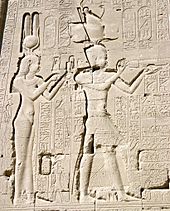
The Ptolemaic Kingdom was a strong Greek-speaking state that stretched from southern Syria to Cyrene and south to Nubia. Alexandria became the capital city and a major center for Greek culture and trade. To be accepted by the Egyptian people, the Ptolemies presented themselves as the successors to the pharaohs. Later Ptolemaic rulers adopted Egyptian traditions. They were shown on public monuments in Egyptian style and clothing, and they took part in Egyptian religious life.
The Ptolemies faced rebellions from native Egyptians. They were also involved in foreign and civil wars, which led to their kingdom's decline. Finally, Rome took over Egypt. However, Greek culture continued to be important in Egypt even after the Muslims arrived. The native Egyptian, or Coptic, culture also continued to exist. The Coptic language was widely spoken until at least the 900s AD.
Roman Egypt
Egypt as a Roman Province
Egypt quickly became the "breadbasket" of the Roman Empire. It supplied most of the Empire's grain, along with flax, papyrus, glass, and other goods. The city of Alexandria became a very important trading hub for the Roman Empire. Ships from Egypt regularly traveled to India and Ethiopia. Alexandria was also a leading center for science and technology. Scholars like Ptolemy, Hypatia, and Heron made new discoveries in astronomy, math, and other fields. Culturally, Alexandria sometimes rivaled Rome in its importance.
Christianity in Egypt
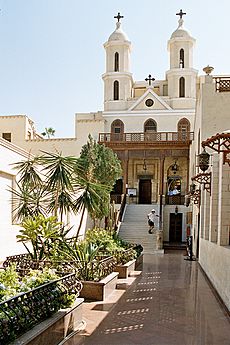
Christianity arrived in Egypt quite early, in the first century AD. Alexandria and Antioch (in Syria) quickly became major centers of Christianity. During the rule of Emperor Diocletian, many Egyptian Christians were persecuted. The New Testament was translated into Egyptian around this time. After a church meeting called the Council of Chalcedon in AD 451, a distinct Egyptian Coptic Church was formed.
Persian Control
Sasanian Egypt refers to a short period from 619 to 629 AD when the Persian Empire ruled Egypt and parts of Libya. This lasted until a Persian rebel made a deal with the Byzantine emperor, and control of Egypt was returned to the Byzantines.
Early Islamic Egypt
The Byzantines regained control of Egypt after the brief Persian invasion. But from 639 to 642 AD, Egypt was invaded and conquered by the Arab Islamic Empire. Losing Egypt was a huge blow to the Byzantine Empire, which relied on Egypt for many goods.
When the Arabs defeated the Byzantine armies, they brought Sunni Islam to Egypt. Early in this period, Egyptians began to mix their new faith with their Christian traditions and other local beliefs. This led to the development of various Sufi groups that are still active today.
Late Medieval Egypt
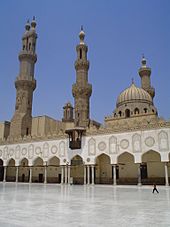
Muslim rulers, chosen by the Islamic Caliphate, controlled Egypt for the next six centuries. Cairo became the seat of the Caliphate under the Fatimids. After the Ayyubid dynasty ended, the Mamluks took control around 1250 AD. The Mamluks were a military group of Turkic and Circassian origin. By the late 1200s, Egypt was a key link for trade between the Red Sea, India, and other eastern lands. The Greek and Coptic languages and cultures slowly declined, and Arabic culture became more dominant.
The Mamluks continued to rule Egypt until the Ottoman Turks conquered it in 1517. After this, Egypt became a province of the Ottoman Empire. The Black Death in the mid-1300s killed about 40% of Egypt's population.
-
Ayyubid Sultanate of Egypt (in pink) at the death of Saladin in 1193
-
Extent of the Mamluk Sultanate under Sultan an-Nasir Muhammad
Ottoman Egypt
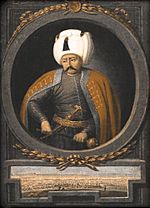
After the 1400s, the Ottoman invasion caused Egypt's system to decline. Its military focus harmed its society and economy. This weakening, along with the effects of the plague, made Egypt vulnerable to foreign invasion. Portuguese traders took over much of Egypt's trade. Egypt suffered from several famines between 1687 and 1731. A famine in 1784 caused about one-sixth of its population to die.
The short French invasion of Egypt led by Napoleon Bonaparte began in 1798. This campaign led to the discovery of the Rosetta Stone, which helped create the study of Egyptology. Despite early victories, Napoleon and his army were eventually defeated and forced to leave, especially after the French fleet was destroyed at the Battle of the Nile.
Muhammad Ali Dynasty
After the French left in 1801, there were four years of chaos as Ottomans, Mamluks, and Albanians fought for power. From this confusion, Muhammad Ali of Egypt, the commander of the Albanian regiment, became a powerful leader. In 1805, the Ottoman Sultan recognized him as his ruler in Egypt. This title suggested he was under the Sultan, but in reality, Ottoman power in Egypt was over. Muhammad Ali was an ambitious and capable leader. He started a dynasty that ruled Egypt until the revolution of 1952. After 1882, this dynasty became controlled by the British.
Muhammad Ali focused mainly on his military. He took over Northern Sudan (1820–1824), Syria (1833), and parts of Arabia and Anatolia. But in 1841, European powers, worried he might overthrow the Ottoman Empire, forced him to return most of his conquests. He kept Sudan, and his right to rule Egypt became hereditary. A lasting result of his military goals was that he had to modernize the country. He wanted to use the military and industrial methods of the great powers. So, he sent students to the West and invited training missions to Egypt. He built industries, a system of canals for irrigation and transport, and improved the government.
In 1820, long-staple cotton was introduced. This Egyptian cotton became famous and changed the country's farming into a single crop system by the end of the century. This had huge social effects. Land ownership became concentrated, and many foreigners arrived, shifting production towards international markets.
British Control (1882–1952)
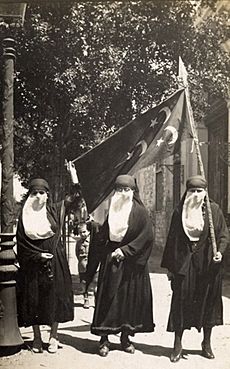
British indirect rule lasted from 1882, when the British defeated the Egyptian Army at Tel el-Kebir and took control. It ended with the 1952 Egyptian revolution which made Egypt a republic and when British advisors were sent away.
Muhammad Ali was followed by his son Ibrahim (briefly in 1848), then by his grandson Abbas I (in 1848), then by Said (in 1854), and Isma'il (in 1863).
Abbas I was careful. Said and Ismail were ambitious builders, but they spent too much money. The Suez Canal, built with the French, was finished in 1869. The cost of this and other projects led to huge debts to European banks. It also caused public anger because of the heavy taxes needed. In 1875, Ismail sold Egypt's 44% share in the canal to the British Government.
Ismail also tried to conquer the Ethiopian Empire but was defeated twice. Within three years, this led to Britain and France placing their own financial controllers in the Egyptian government. These controllers, backed by the banks, became the real power.
Local unhappiness with Ismail and European interference led to the first nationalist groups forming in 1879. Ahmad Urabi was a key figure. In 1882, he led a nationalist government that wanted democratic changes, including parliamentary control over the budget. Fearing they would lose control, Britain and France sent their military. They attacked Alexandria and crushed the Egyptian army. They put Ismail's son Tewfik in charge, but Egypt was effectively a British protectorate.
In 1914, the Protectorate became official, and the Ottoman Empire no longer had a role. The title for the head of state changed from pasha to khedive, and then to sultan. Abbas II was removed as khedive and replaced by his uncle, Hussein Kamel, as sultan.
After World War I, Saad Zaghlul and the Wafd Party led the Egyptian nationalist movement. When the British sent Zaghlul away to Malta in March 1919, the country had its first modern revolution. This revolt led the British government to declare Egypt's independence in February 1922.
The new government wrote a constitution in 1923, based on a system with a parliament. Saad Zaghlul was elected as Prime Minister of Egypt in 1924. In 1936, the Anglo-Egyptian Treaty was signed. Continued instability due to British influence and the king's growing political involvement led to the parliament being dissolved in a military takeover, known as the 1952 Revolution. The Free Officers Movement forced King Farouk to give up his throne to his son Fuad.
British military presence in Egypt lasted until 1954.
Republican Egypt (since 1953)
On June 18, 1953, the Egyptian Republic was declared. General Muhammad Naguib became the first President. Naguib was forced to resign in 1954 by Gamal Abdel Nasser, who was the real leader of the 1952 movement. Naguib was later put under house arrest.
Nasser's Time as President
Nasser became president in June 1956. British forces finished leaving the Suez Canal Zone on June 13, 1956. Nasser then took control of the Suez Canal for Egypt on July 26, 1956. This led to the Suez Crisis in 1956.
In 1958, Egypt and Syria formed a union called the United Arab Republic. This union was short-lived and ended in 1961 when Syria left. During most of its existence, the United Arab Republic was also loosely connected with North Yemen.
In the Six-Day War of 1967, Israel invaded and took over Egypt's Sinai Peninsula and the Gaza Strip. Three years later, in 1970, President Nasser died. He was replaced by Anwar Sadat.
Sadat's Time as President
Sadat changed Egypt's alliances during the Cold War, moving from the Soviet Union to the United States. He sent Soviet advisors away in 1972. He started an economic reform policy and cracked down on opposition groups.
In 1973, Egypt, along with Syria, launched the October War. This was a surprise attack against Israeli forces in the Sinai Peninsula and the Golan Heights. It was an attempt to get back some of the land Israel had captured six years earlier. Sadat hoped to regain territory by force and then get the rest back through diplomacy. The war caused an international crisis between the US and the USSR. While the war ended in a military stalemate, it was a political victory for Sadat. This later allowed him to regain the Sinai in exchange for peace with Israel.
Sadat made a historic visit to Israel in 1977. This led to the peace treaty in 1979, where Israel withdrew from Sinai. Sadat's actions caused a lot of debate in the Arab world and led to Egypt being expelled from the Arab League. However, most Egyptians supported it. On October 6, 1981, Sadat was assassinated during a military parade. He was succeeded by Hosni Mubarak.
Challenges and Unrest
In the 1980s, 1990s, and 2000s, there were many serious attacks in Egypt. These attacks sometimes targeted Christians and foreign tourists, as well as government officials.
The 1990s saw a group called al-Gama'a al-Islamiyya carry out a campaign of violence. This included attacks on writers and intellectuals, and repeatedly targeting tourists. This caused serious harm to Egypt's tourism industry, which is a big part of its economy. It also hurt the livelihoods of many people.
From 1992 to 1997, over 1,200 people were victims of this campaign against the Egyptian state. This included police officers and European tourists. At times, travel by foreigners in parts of Upper Egypt was very restricted and dangerous. On November 17, 1997, 62 people, mostly tourists, were killed near Luxor. The attackers trapped people in the Mortuary Temple of Hatshepsut.
Civil Unrest (2011–2014)
The 2011 Revolution
In 2003, a group called Kefaya (meaning "Enough" in Arabic) was formed. It aimed to oppose the Mubarak government and push for democratic changes and more freedoms.

On January 25, 2011, large protests began against Mubarak's government. The goal was to remove Mubarak from power. These protests involved many people and mainly consisted of continuous large demonstrations. By January 29, it was clear that Mubarak's government had lost control. A curfew order was ignored, and the army took a somewhat neutral stance.
On February 11, 2011, Mubarak resigned and left Cairo. Vice President Omar Suleiman announced that Mubarak had stepped down and that the Egyptian military would take control for a short time. Joyful celebrations broke out in Tahrir Square.
On February 13, 2011, the military announced that both the constitution and the parliament had been dissolved. A new parliamentary election was planned for September. A vote on a new constitution was held in March 2011. In November 2011, Egypt held its first parliamentary election since Mubarak's fall. Voter turnout was high, and there were no reports of violence.
Morsi's Presidency
The first round of a presidential election was held in Egypt in May 2012. Mohamed Morsi won 25% of the vote, and Ahmed Shafik, the last prime minister under Mubarak, won 24%. A second round was held in June. On June 24, 2012, Mohamed Morsi was announced as the winner, making him Egypt's first democratically elected president. He took 51.7 percent of the vote. On June 30, 2012, Mohamed Morsi was sworn in.
In July 2012, President Morsi announced he was overturning the military's decision to dissolve parliament. He called lawmakers back into session. However, the Supreme Constitutional Court of Egypt later canceled Morsi's decision.
In November 2012, Morsi issued a declaration that made his decrees immune from challenge. He also aimed to protect the work of the assembly writing the new constitution. This declaration allowed Morsi to take any steps needed to protect the revolution. This move was criticized by many, who said Morsi was taking too much power. It led to large protests and violence across Egypt.
Morsi offered a "national dialogue" with opposition leaders but refused to cancel a vote on a draft constitution. A constitutional referendum was held in December 2012. It passed with 64% support. On July 3, 2013, the constitution was suspended by order of the Egyptian army.
On June 30, 2013, on the first anniversary of Morsi's election, millions of protesters demanded his immediate resignation. On July 1, the Egyptian Armed Forces gave the political parties 48 hours to meet the people's demands. On July 3, General Abdel Fattah el-Sisi, head of the Egyptian Armed Forces, announced that Morsi had been removed from power. He suspended the constitution and called for new elections. He named Adly Mansour as acting president.
After Morsi
In the months after the military takeover, a new constitution was prepared and took effect in January 2014. Presidential and parliamentary elections were held.
El-Sisi's Presidency
In the elections of June 2014, El-Sisi won with 96.1% of the vote. On June 8, 2014, Abdel Fatah el-Sisi was officially sworn in as Egypt's new president. Egypt has put in place strict controls on its border with the Gaza Strip, including taking down tunnels.
In April 2018, El-Sisi was re-elected by a large margin in an election with no real opposition. In April 2019, Egypt's parliament extended presidential terms from four to six years. President Abdel Fattah al-Sisi was also allowed to run for a third term in the next election in 2024.
Under El-Sisi, Egypt is said to have returned to a more authoritarian style of government. New constitutional changes have been made, strengthening the military's role and limiting political opposition. These changes were accepted in a referendum in April 2019.
In December 2020, the final results of the parliamentary election confirmed that Egypt's Mostaqbal Watn (Nation's Future) Party had a clear majority. This party strongly supports President El-Sisi.
Images for kids
-
Egyptian soldier of the Achaemenid army, around 470 BCE. From Xerxes I tomb relief.
See also
 In Spanish: Historia de Egipto para niños
In Spanish: Historia de Egipto para niños
- History of Cairo
- History of Alexandria
- List of Egyptian inventions and discoveries
- Population history of Egypt
- Timeline of Alexandria
- Timeline of Cairo





